Future-proofing Interactive Works
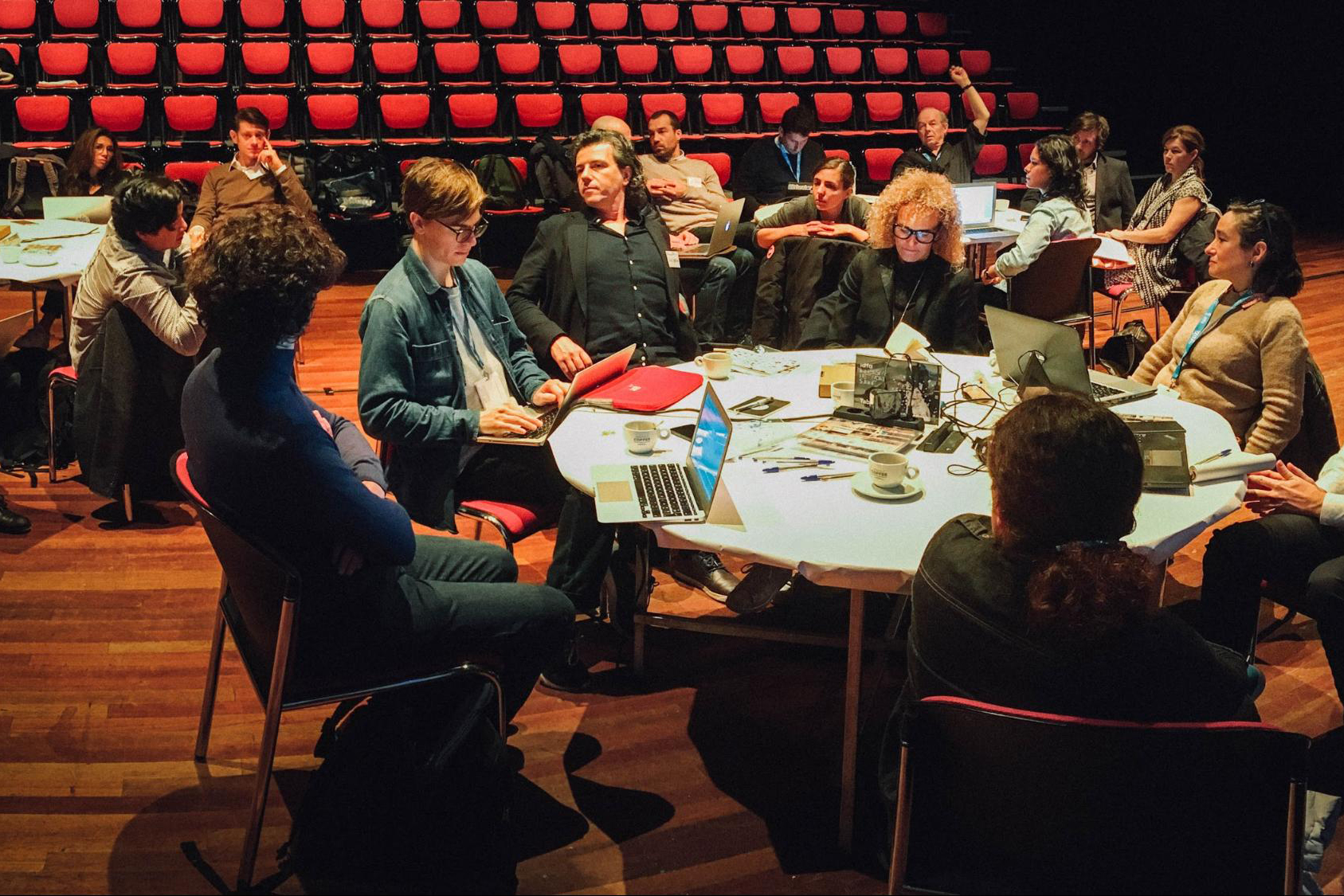
with notes from William Uricchio, Lieven Heeremans, Mikey Zbieranowski, and Tatiana Villacob
DocLab Preservation Expert Panel
It’s tricky business to keep a digital object useful over a long period of time. The challenges are alike for private individuals, production houses, government bodies, museums and archivists: Technology changes and it changes fast. Drives won’t spin up, connectors won’t fit the machinery, software doesn’t play well with any old operating system, ... fully functioning play-out is never certain with programmes that did n ’t get to catch up, weren’t updated or migrated in time.
Interactive media productions brought along the promise of breaking down publishing silos. Photographers no longer shoot still images only. Writers no longer produce letters on paper. Likewise, transmedia forms and formats deeply unsettled tried and tested preservation and presentation tactics. Media archivists have decades of experience with storing often unstable moving images. Yet a carefully labeled tape or film reel in top-notch climate controlled conditions is a far cry from safeguarding interactives that draw on GPS, webcams, touch screens and API s. The speed at which our media environment evolves makes the task of ensuring that this type of production can confidently be re-represented in the far-flung future particularly difficult.
Keeping digital artworks, intricate interactive stories, bubbly browser movements and geolocation robots is therefor e all the trickier. During this year’s DocLab opening night, Zackary Canepari, who returned to Amsterdam with a new project, remarked that his five-year old nomination California is a Place is now “a website that barely even loads anymore”. The death of Adobe Flash, announced for many years, is now happening, rapidly and for real, with popular browsers pulling support. Which led IDFA DocLab’s curator Caspar Sonnen to remark that Flash is now “the nitrate of the digital era”.
Still from Decasia, Bill Morrison’s ode to decaying nitrate stock
Preservation means presentation. The latter cannot happen without the former. In the words of French audiovisual archive Ina’s Daniel Teruggi: our age is the first time in history where producers need to be concerned with the preservation of their creations while they’re still making them! Over the past ten years, the IDFA Doclab programme has presented a host of ground-breaking storytellers and tech-savvy creators. Their works engage us, amaze us, draw us in with creations at the ever-forward-edging front of what consumer technologies allow them to do. These ten years have produced a showcase of talent, inventiveness and often playfulness from digital creators around the globe. On November 21, IDFA DocLab and the Netherlands Institute for Sound & Vision brought together a host of experts [1] to discuss what it would take to future-proof some of the works that have found their way to the Amsterdam DocLab stage. We asked these archivists, curators, publishers, developers, professors and producers to look at three specific cases. The goal being to lay out the options that exist for keeping this creation alive for the future and come up with a clear-cut project plan.
Approaches
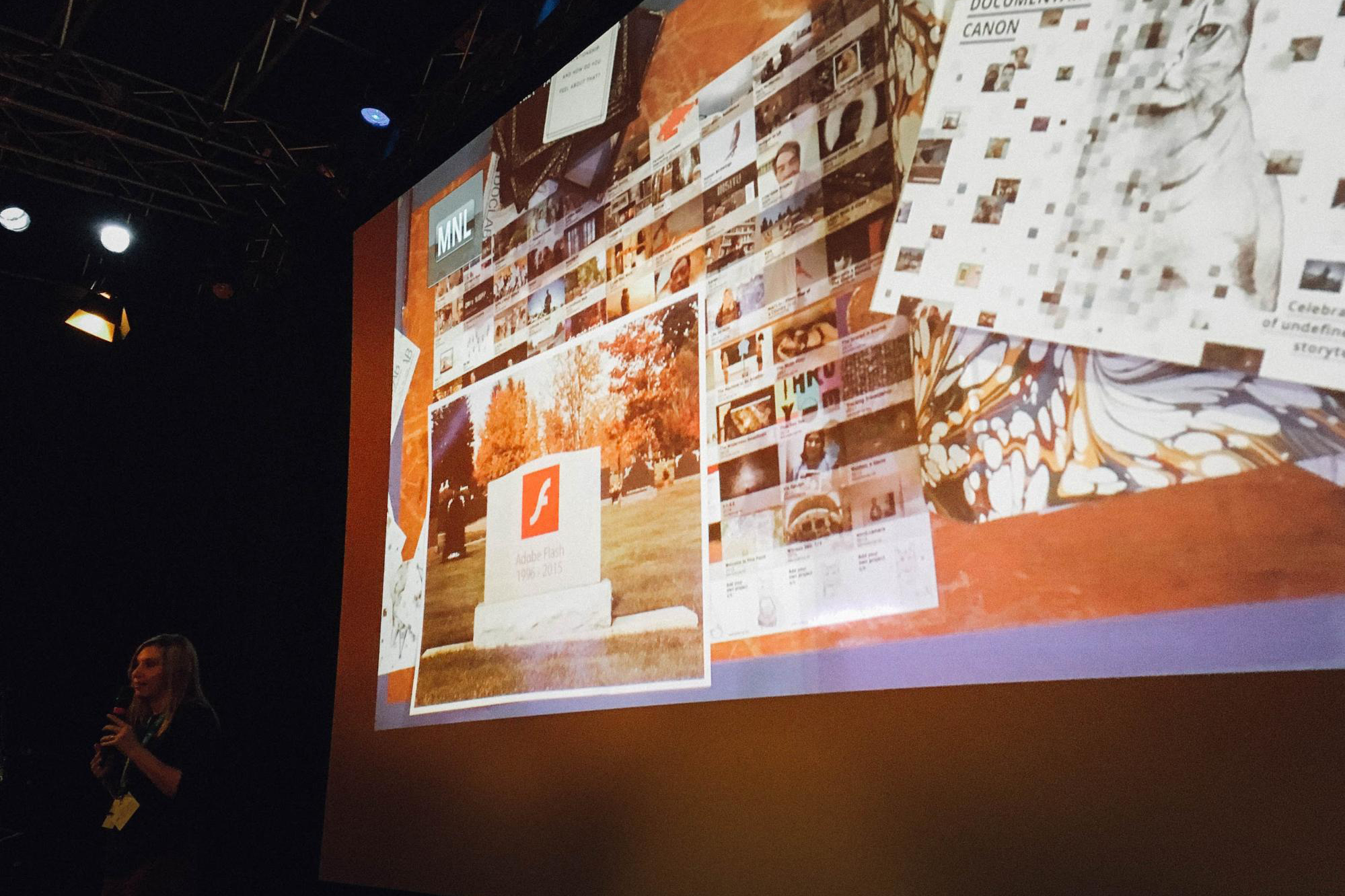 Image credit: Erwin Verbruggen CC BY 4.0
Image credit: Erwin Verbruggen CC BY 4.0
As professor William Uricchio underlined, there’s a few different elements and strategies one can lean on when thinking about safeguarding an interactive.
- Interdependency: While some interactive projects are effectively closed systems, many others are integrated with APIs such as Google Maps; operating systems such as Android and iOS; platforms such as Twitter; and services based on time-bound standards such as GPS. These autonomous, often transient (in the sense of frequent updates), and always conditional (eg, legal terms) factors are outside the control of individual projects, yet intrinsic to them. Interdependency perhaps more than any other feature distinguishes the preservation and access needs of interactive documentaries, compared to analog media or even digital games and art.
- Maintenance: Who should assume responsibility for maintaining these projects, in paying for their hosting, covering their server costs, curating possible interfaces with the public, and so on? The makers? Designers? Producers? Some other party? The complexities of ‘ownership’ and the mixed responsibilities on the production and distribution fronts seem to have led to a situation where everyone and no one has a say in the fate of these forms. We need to establish protocols and norms for artifact maintenance. An important sub-question regards how ongoing data acquisition will be maintained (to the extent that it is a relevant part of the project). If user data is relevant to a particular project, who ‘owns’ and can dispose of it? How will it be maintained as part of the preservation project?
- Letting go: Which aspects of an increasingly ephemeral culture do we need to be prepared to abandon? Many digital artifacts regularly morph over time, with upgrades, user modifications, and platform shifts. ‘Completionist’ strategies of the past are not particularly helpful in this regard. Yet it is imperative that we answer this question if we are to decide among preservation, documentation and creative interpretation, and determine which relevant analogies to other media practice to draw upon (emulators and games; migration and certain art projects, and so on).
Case Study 1: ALMA — A Tale of Violence (Upian)
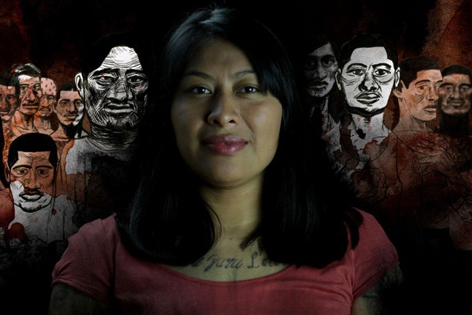 Still from Alma
Still from Alma
The story of upian & Arte’s Alma is a powerful and timeless one. The technology it’s built with less so. The group discussed earlier experiences with porting the project from iOS to Android. Because of the differences between the two platforms, the producers were forced to fully rebuild parts of one when they updated the other. A number of important questions around interactive documentary preservation came up in the group: Should you, as a producer, recode a piece? Film the director’s cut? Is it your role to do so? Do you have the time? And money? Will you be forced to do it all over again in three years time? The group looked at the possibilities of Rhizome’s Webrecorder software as a solution for preserving a project like Alma. Its encapsulated browser has a version of Flash that is running inside an emulator environment: a browser inside a browser that records the user interactions of the original piece. For interactive documentaries to be fully preserved in Web-recorder, you need to execute every possible user interaction. Programs where the user can take multiple paths can seem problematic as they might well contain millions of possible interactions.
You also have the question of how to preserve the emulator software: will that exist in another ten years time? For other web-artworks that Rhizome has successfully preserved, the artists provided them with the entire server. Which makes archiving going backward a problem, as these servers have likely been lost, or changed. A piece like Alma or Do Not Track has network data of each user, which is essential to the piece. The group proposed to add the term ‘user’s cut’ to the existing idea of creating a “director’s cut” - the way in which the Live DocLab events have brought a director’s vision of how the interactive should be approached to the stage. Another element that came up with Alma’s case is security. The protagonist of the story has a violent background, and to protect her safety, the story is locked out of certain parts of the world. A protection measure that, when recorded with software like Webrecorder, is unlikely to be preserved if not given the appropriate amount of attention.
Case Study 2: Do Not Touch (Moniker)
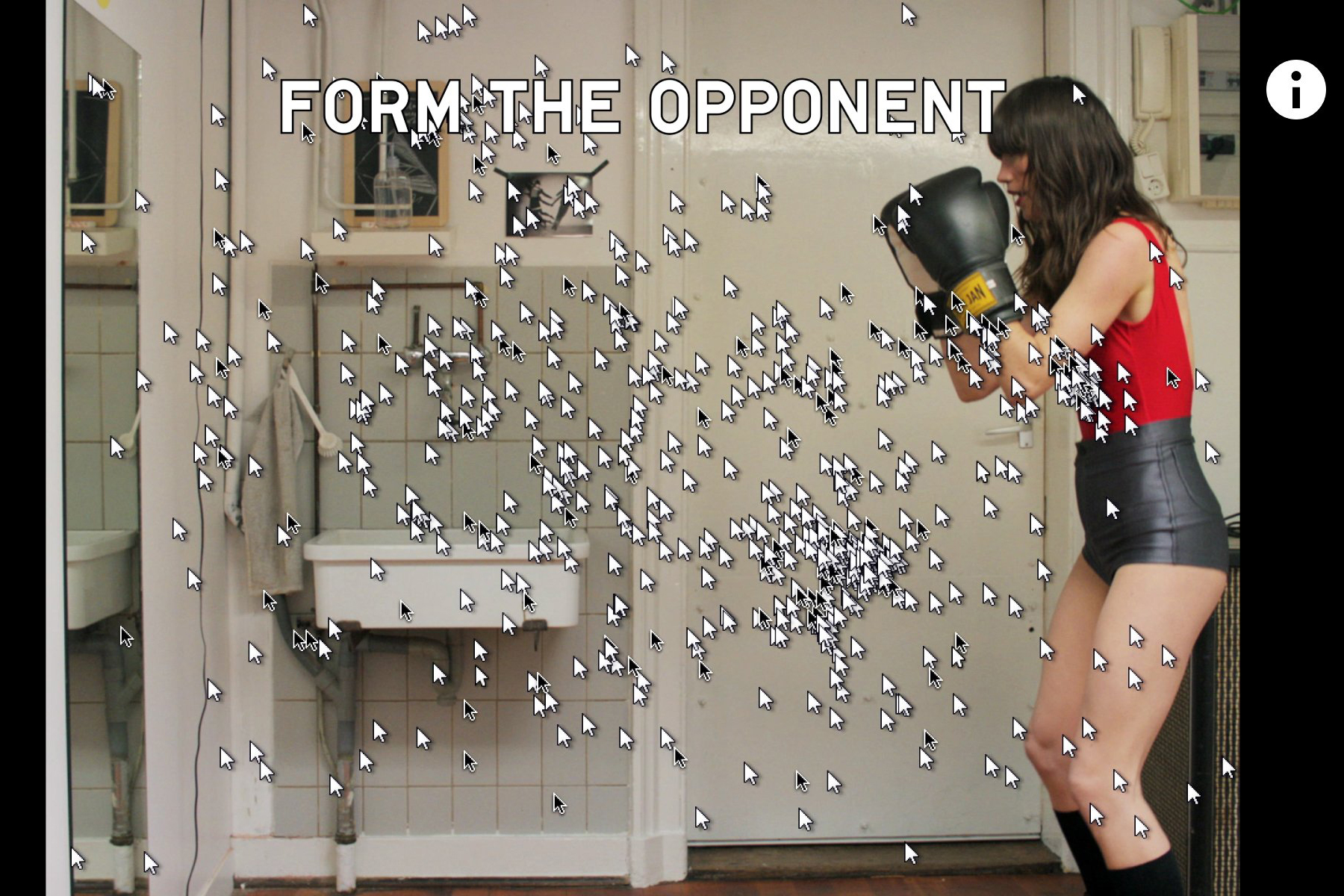 Still from Do not Touch
Still from Do not Touch
Moniker presented the project Do not touch, an interactive crowdsource experience, consisting on the capture of the movements of the computer’s cursor of the user to generate a video that is uploaded on a Vimeo account linked to the Website of the project. A new video is generated every day according to the data gathered, so it’s never the same video. As key components of the work they have the private company server where the data is uploaded in order to generate the video, a Vimeo account where the videos are posted and a HTML website that hosts the project. Some relevant things that happened along the process of the project: the studio received a call from Vimeo because every night the “same” video was being uploaded into the account, storing the 4k master of each video was useless as at the end the video shown was in a lower quality compression.
When asked what was becoming outdated in the project, the producer replied that to their surprise, as desktops are used less and less and replaced by mobile touch screen technologies, the use of the mouse and therefore of a cursor was disappearing. This is a fact they never considered when developing the project and so it now transformed into a monument to the cursor. The preservation of this work could therefore be framed as the celebration of the end of something - in this case the end of the use of the cursor. Another question that arose in the table was related to the risk assessment of the technologies involved in the project. What would happen if Vimeo went down? Or HTML5 moves on? How are they handling the documentation of the evolvement of the project? All agreed that as both technologies - essential to the project - are still valid, the project still has some years of life. The documentation process and its organization will however prove to be vital for its future existence.
Moniker indicated that documenting the creation and evolution processes of their works has always been important. Specifically for Do not touch, they document the code and its changes, as well as store all the generated videos. Earlier, the Breda-based MOTI Museum had approached the studio in order to preserve a work of theirs. After first wanting to buy the code but never having thought about the cost of maintenance and hosting, they agreed to a 5-year maintenance contract. Sonnen asked whether for future audiences, who won´t even know what a cursor is, this work should even be preserved? As a curator, part of his work is trying to detect timeless masterpieces. Do not touch was clearly not created with that purpose - but is now becoming so because of the way technology changes.
Case Study 3: Bear 71 (NFB)
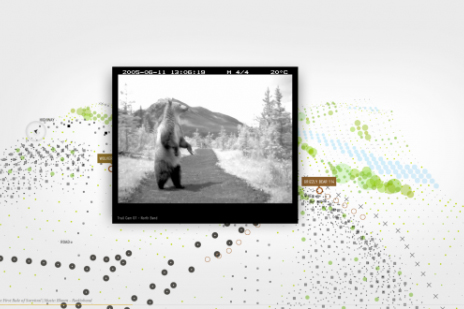 Still from Bear 71
Still from Bear 71
Even though the interactive web documentary Bear 71 was created as recent as 2012, its producers pro-actively tried to preserve their project by building a reimagined and re-released virtual reality experience. This first of all raises the question: is this actually preservation, an adaptation or a whole new project? The main difference in this adaptation is obviously the transition from Flash to HTML5 on the front end. The Apache, JSON and PHP backend remained largely intact. The webcam, navigation, multi-user server and the interactive security wall were lost in the adaptation. In terms of platform, Virtual Reality as a medium cannot be considered stable or accessible yet. Group members stressed that the goal of WebVR is to be platform agnostic but that Flash used to be more accessible to inexperienced designers while WebVR still isn’t.
For new media, such as web-based projects, there are virtually no public repositories or archives being produced. There is a real need for ‘archival nerds’, as the group called them, for web projects to set these up. This is because the mere materiality of aging technology: even if you build and publish everything on open standards, it’s not possible to just download projects on your computer and run them . Initiatives like the Internet Archive’s Wayback Machine are promising and fulfil a real need, but do not provide full functionality for interactive elements.
Before Bear 71 VR, there were two iterations of the project: a live event with music performed on stage and an interactive wall. These iterations have not been preserved but might offer creative solutions for other, more durable versions of the project like a book. Group members stressed that each audience has a specific use case. Other makers who want to learn from the creation process would approach archived content different from for example historians. In the Netherlands, both Sound & Vision and LIMA have been recording audiences and players interacting with a video game or artwork - ‘Let’s play’ videos - that add layers of meaning to the archived materials. In the same line, ARTE is recording Twitch streams of the creation process. One light-hearted suggestion was to simply store all these materials on celluloid again.
The group talked about the difference in the pace of development of standards in the industry versus institutions. More collaboration between these partners could lead to better preservation practices. A final note that came up was how often times ‘pirates’, as is the case in many other areas of internet expertise, are very progressive when it comes to preservation. They can be and sometimes already are a useful ally to gather information on archival practices. Although we might not have reached a solution, many important questions were raised that help us think about the future of preserving interactive documentaries.
In Non-conclusion
The challenge of dynamically preserving interactive works is far from solved. There might not yet be some universally agreed-upon best practices, holding places, legal frameworks, and technological solutions, but we were able to talk about what good practices could look like. Museums presenting media and net art have decades of experience with format migration. The digital games community established rich experience with emulating various operating system and browser emulators. Archives around the globe have been working together for two decades now trying to solve the web archiving puzzle. The question we aimed to approach in this session therefore, was seeing whether, by focusing on three specific cases, to what extent these projects call for unique case-by-case solutions, or share common traits that can be applied to all. Some of the participants developed technological solutions that to some extent can work already with the use cases we gathered for this expert session. [2] But as came up often throughout these three conversations, technology is not the only piece of the puzzle. Establishing who is responsible for the maintenance, for the updates, for porting elements relying on extinct technology is equally, if not more important. In the discussion, it was highlighted that the technological changes are also influencing the skillset of human talent. At some of the participating production houses, none of the current developers is trained in Flash, so they have to refer to external human talent in order to work on preserving their earlier works. Independent documentarians in the room warned that most of their interactive documentary works were owned by other people or companies that, in some cases, already no longer exist. So thinking about preserving some of these pieces is even more complicated when there isn’t even a clear perspective on who´s owning the rights to these works. This conversation is not over. At most and only - yet another - beginning.
 Image credit: Erwin Verbruggen CC BY 4.0
Image credit: Erwin Verbruggen CC BY 4.0
[1] Expert panel participants: Alexandre Brachet & Margaux Missika (upian), Loc Dao & Janine Steele (National Film Board of Canada), Marianne Lévy-Leblond & Stéphane Nauroy (ARTE France), Dragan Espenschied (Rhizome), William Uricchio & Sarah Wolozin (MIT Open Documentary Lab), Myriam Achard (Phi Centre), Bruno Felix & Remco Vlaanderen (Submarine Channel), Klaus Rechert (Freiburg University), Erwin Verbruggen & Jesse de Vos (Netherlands Institute for Sound & Vision), Jessica Brillhart (Google), Brett Gaylor (Mozilla Foundation), Roel Wouters (Studio Moniker), Cal Lee (Chapel Hill University), David Desrimais (Jean Boîte Editions), Caspar Sonnen, Lieven Heeremans, Mikey Zbieranowski (IDFA DocLab), and Tatiana Villacob.
[2] BitCurator , Freiburg University’s bwFLA emulation service , and Rhizome’s Webrecorder, to name a few.
